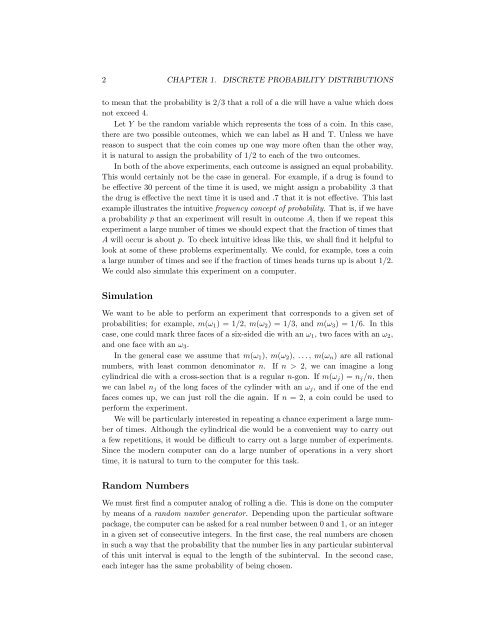Chapter 1 Discrete Probability Distributions - DIM
Chapter 1 Discrete Probability Distributions - DIM
Chapter 1 Discrete Probability Distributions - DIM
- No tags were found...
You also want an ePaper? Increase the reach of your titles
YUMPU automatically turns print PDFs into web optimized ePapers that Google loves.
2 CHAPTER 1. DISCRETE PROBABILITY DISTRIBUTIONSto mean that the probability is 2/3 that a roll of a die will have a value which doesnot exceed 4.Let Y be the random variable which represents the toss of a coin. In this case,there are two possible outcomes, which we can label as H and T. Unless we havereason to suspect that the coin comes up one way more often than the other way,it is natural to assign the probability of 1/2 to each of the two outcomes.In both of the above experiments, each outcome is assigned an equal probability.This would certainly not be the case in general. For example, if a drug is found tobe effective 30 percent of the time it is used, we might assign a probability .3 thatthe drug is effective the next time it is used and .7 that it is not effective. This lastexample illustrates the intuitive frequency concept of probability. That is, if we havea probability p that an experiment will result in outcome A, then if we repeat thisexperiment a large number of times we should expect that the fraction of times thatA will occur is about p. To check intuitive ideas like this, we shall find it helpful tolook at some of these problems experimentally. We could, for example, toss a coina large number of times and see if the fraction of times heads turns up is about 1/2.We could also simulate this experiment on a computer.SimulationWe want to be able to perform an experiment that corresponds to a given set ofprobabilities; for example, m(ω 1 )=1/2, m(ω 2 )=1/3, and m(ω 3 )=1/6. In thiscase, one could mark three faces of a six-sided die with an ω 1 , two faces with an ω 2 ,and one face with an ω 3 .In the general case we assume that m(ω 1 ), m(ω 2 ), ..., m(ω n ) are all rationalnumbers, with least common denominator n. If n>2, we can imagine a longcylindrical die with a cross-section that is a regular n-gon. If m(ω j )=n j /n, thenwe can label n j of the long faces of the cylinder with an ω j , and if one of the endfaces comes up, we can just roll the die again. If n = 2, a coin could be used toperform the experiment.We will be particularly interested in repeating a chance experiment a large numberof times. Although the cylindrical die would be a convenient way to carry outa few repetitions, it would be difficult to carry out a large number of experiments.Since the modern computer can do a large number of operations in a very shorttime, it is natural to turn to the computer for this task.Random NumbersWe must first find a computer analog of rolling a die. This is done on the computerby means of a random number generator. Depending upon the particular softwarepackage, the computer can be asked for a real number between 0 and 1, or an integerin a given set of consecutive integers. In the first case, the real numbers are chosenin such a way that the probability that the number lies in any particular subintervalof this unit interval is equal to the length of the subinterval. In the second case,each integer has the same probability of being chosen.
















